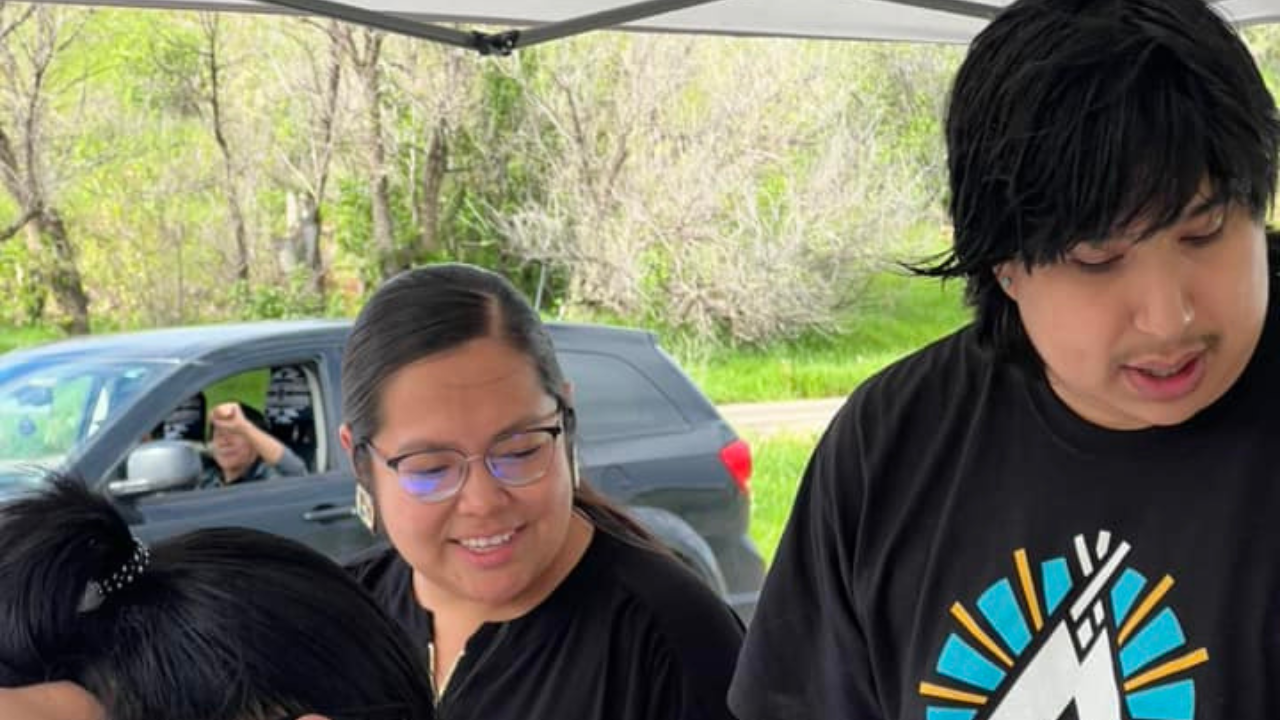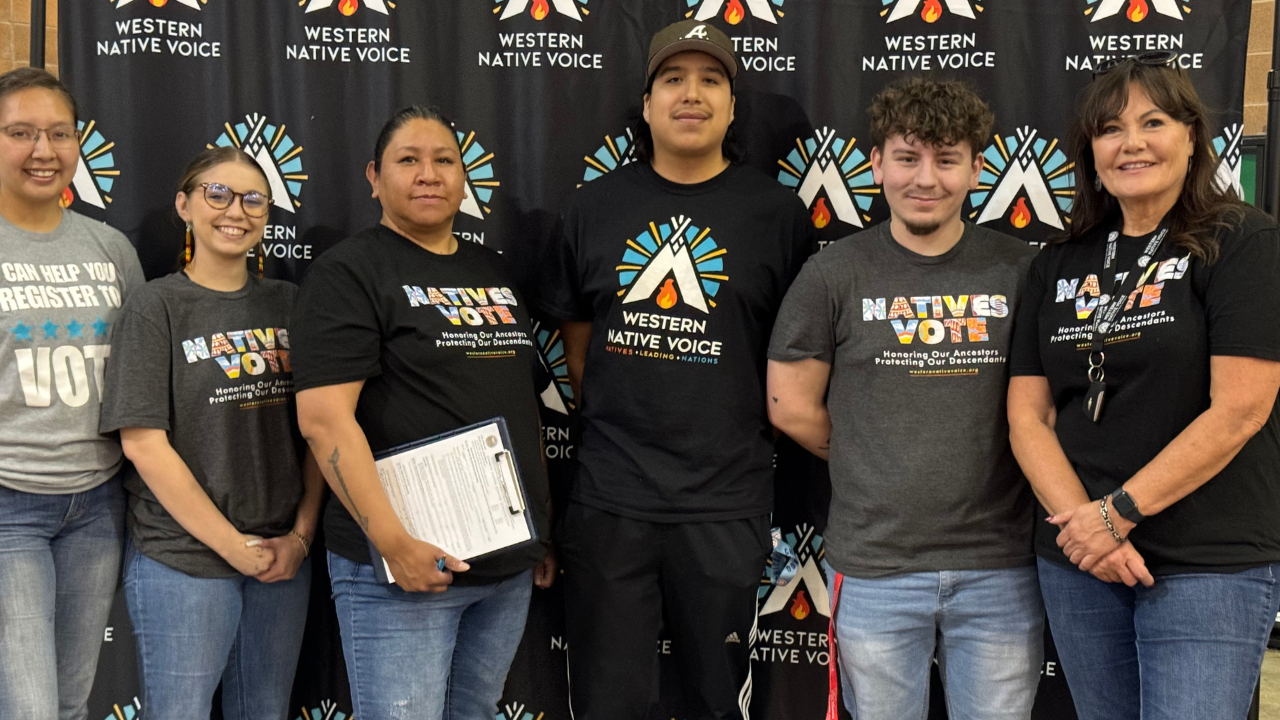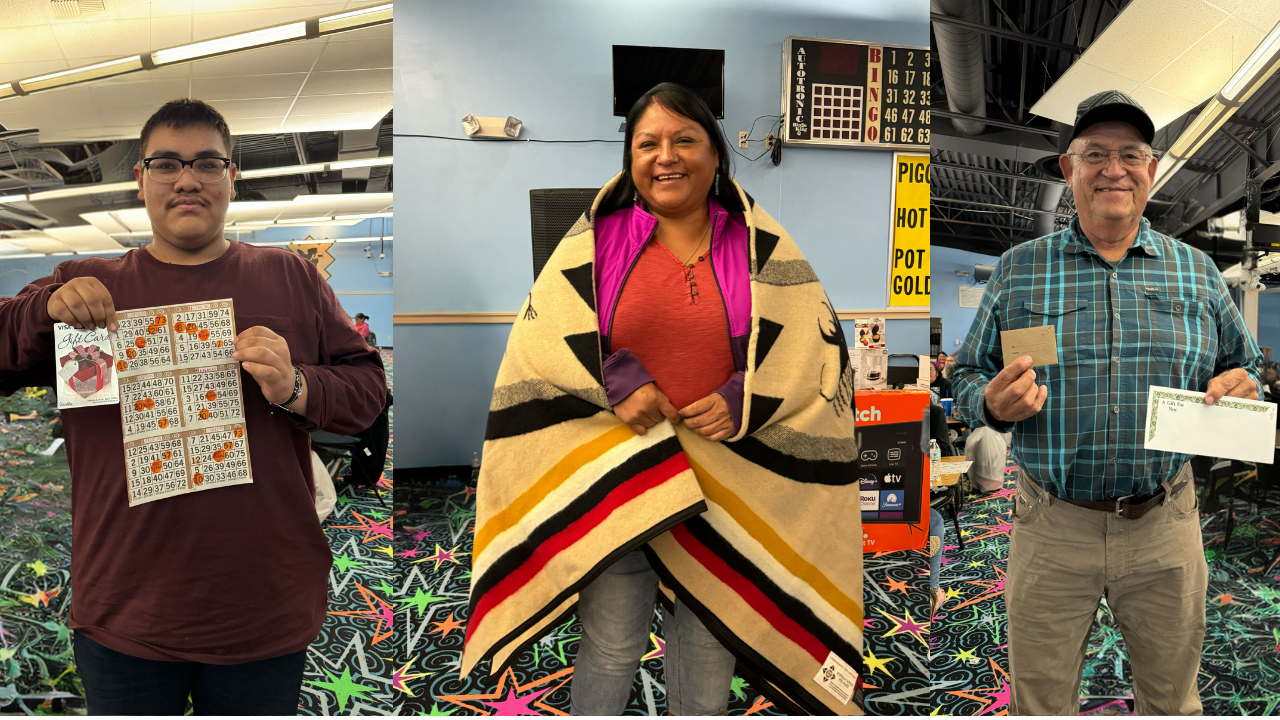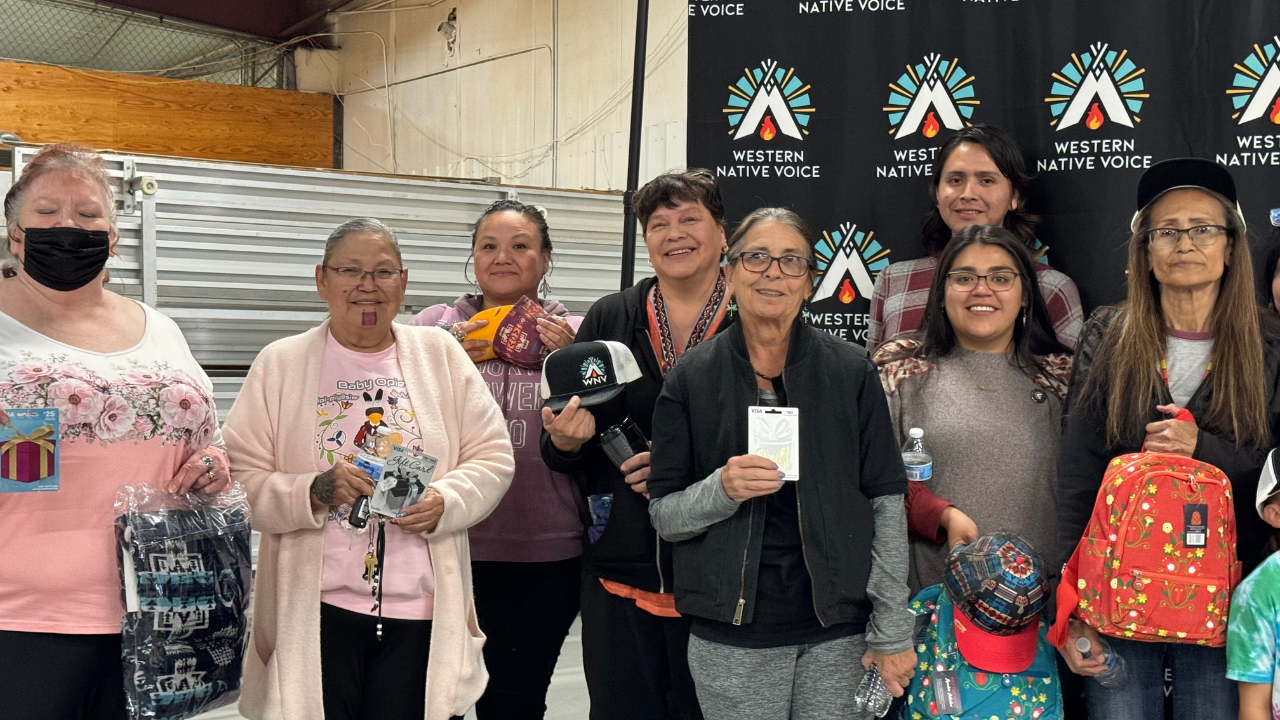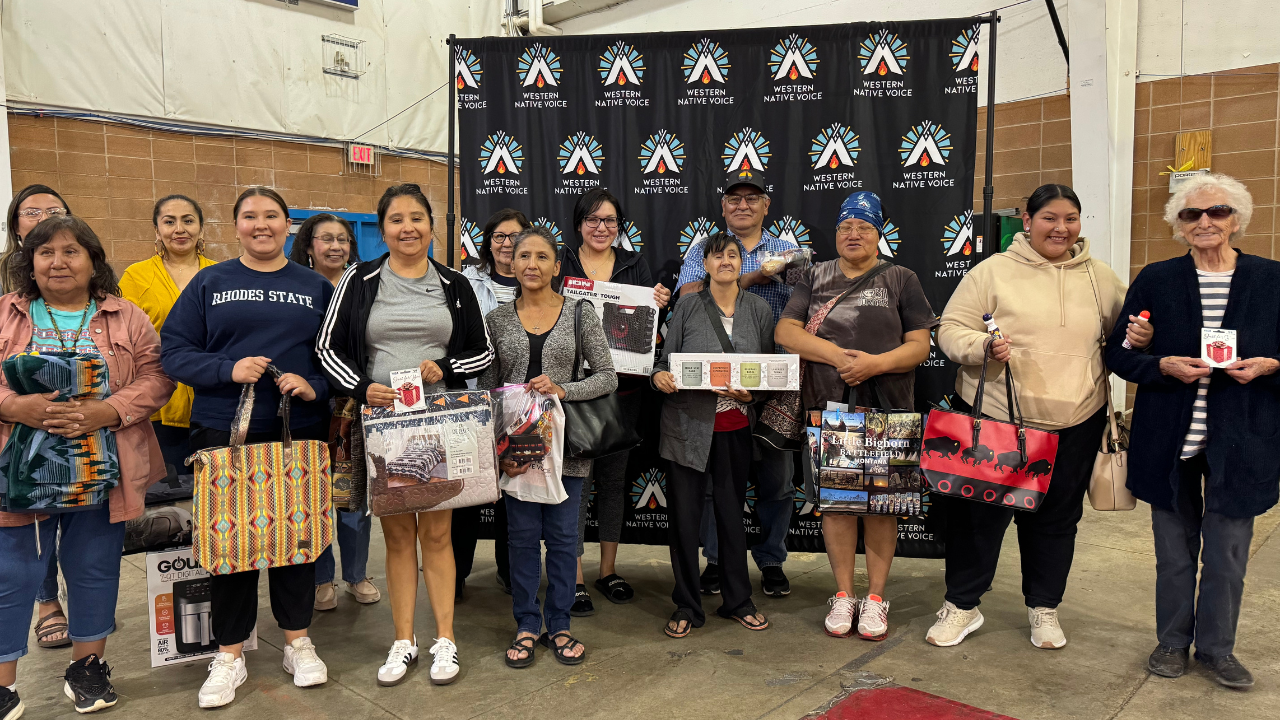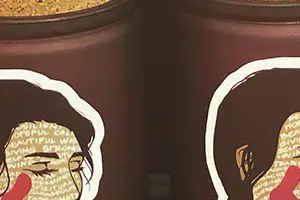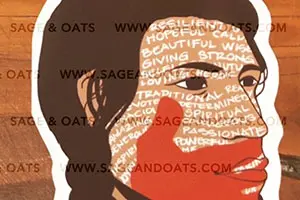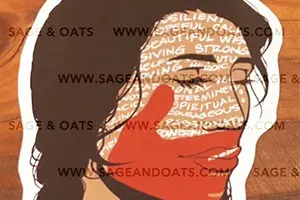In an inspired effort to invigorate civic participation, Western Native Voice (WNV) has launched a new billboard campaign across several Montana Tribal Nations. This initiative, which started in May, strategically places vibrant billboards on the sides of buildings, turning ordinary spaces into powerful messages of advocacy and representation.
Featuring local community members, these billboards are not just public art installations but profound reminders of the importance of voting. Each display vividly illustrates how individual voices in the voting booth contribute to the larger narrative of our communities, histories, and futures.
“Our goal is to make every passerby reflect on their role in our democracy and inspire them to participate in shaping the future of their community,” explained a spokesperson from WNV. This campaign is rooted in the belief that visibility in underserved areas can stimulate a higher engagement rate among voters who might feel disconnected from the electoral process. This effort is particularly poignant in Tribal Nations, where voter turnout has historically been lower than national averages.
The individuals featured on the billboards are chosen for their roles and contributions to their communities, symbolizing the powerful impact that each voter can have. “These are the faces of our past, present, and future,” said the spokesperson. “They remind us that our actions today will echo in the lives of generations to come.”
As Western Native Voice continues to expand its reach with more billboards, the message remains clear: voting is not just a right; it is a vital tool for community building and legacy shaping. This initiative hopes to leave an indelible mark on the electorate, encouraging greater participation in upcoming elections and more robust community engagement.
LAME DEER, MT — In a vibrant fusion of cultural celebration and civic engagement, Western Native Voice (WNV), a Native-led nonprofit, recently held a community feed in Lame Deer, Montana. This event, which also functioned as a membership drive, played a pivotal role in increasing voter registration and membership among the Northern Cheyenne.
Historically, Montana’s Native American communities, including the Northern Cheyenne, have seen lower voter turnout, a concern that Western Native Voice aims to mitigate through active community engagement. According to the U.S. Census, voter participation among Native Americans in Montana trails behind national averages, highlighting the critical need for initiatives like this community feed.
“The community feeds are essential not just for gathering and sharing a meal but also for mobilizing our community to use their voices in elections and beyond,” remarked a spokesperson from WNV. The event featured a variety of foods, creating an inviting atmosphere conducive to discussions on civic responsibilities and community involvement.
At the heart of the event were voter registration and membership sign-up stations, staffed by dedicated Western Native Voice staff. This strategic setup was crucial for leveraging the social gathering into a robust platform for political empowerment and community building.
The enthusiastic participation of the community was evident, with families, elders, and youths engaging in rich discussions, exchanging stories, and establishing newmanities. This sense of unity and shared purpose underscored the importance of community ties and collective action. “Events like this are vital for strengthening our community bonds and ensuring that our collective voice is influential in shaping policies that impact our lives,” a staff member of Western Native Voice noted.
By the conclusion of the event, the increase in memberships and voter registrations underscored the successful outreach, with each registration marking a step toward greater representation and influence for the Northern Cheyenne in Montana’s political arena.
For more information on how to get involved with Western Native Voice or to learn more about upcoming events and initiatives, follow us across all social media platforms. Through events like the community feed in Lame Deer, WNV is committed to building a robust and active communities, poised to make significant impacts within Montana’s democratic processes.
On the evenings of May 21 in Lame Deer, May 23 in Fort Belknap, and May 30 in Crow Agency, vibrant Bingo nights hosted by Western Native Voice turned into more than just fun gatherings. These events played a crucial role in fostering community ties and reinforcing the importance of voting among Native American communities.
Using a Beloved Game to Engage Communities
Western Native Voice utilized Bingo, a widely enjoyed game, as a springboard to include educational sessions about voter rights and the electoral process. This blend of fun and learning ensured that while participants enjoyed the familiar game, they also received crucial knowledge that empowered them to engage more actively in their civic duties.
Educational Interludes Amid Entertainment
The Bingo events were interspersed with discussions on crucial civic issues, such as voter registration and the mechanics of voting. These educational segments transformed the gatherings from simple social events into effective platforms for community education and mobilization, aiming to demystify the voting process and encourage greater electoral participation.
Strengthening Community Through Civic Participation
Attending these events signifies more than just a night out; it represents an active commitment to deepening community engagement and governance. For members of Western Native Voice, these events offer opportunities to contribute to the collective empowerment and self-determination of their communities.
Boosting Voter Turnout and Community Involvement
Research supports that community-based initiatives and events significantly increase civic participation and voter turnout. Engaging communities through enjoyable and relevant activities raises awareness about the importance of voting and civic responsibilities, creating a more informed electorate and encouraging greater election impact. A shared sense of responsibility among residents to care for their communities can boost participation in elections, especially in local settings where the impact of individual votes is more pronounced.
The Role of Membership in Strengthening Communities
Membership in Western Native Voice plays a critical role, extending the influence of these events into sustained community benefits. Members become part of a broader initiative that supports ongoing civic engagement, education, and advocacy, strengthening the social fabric and fostering unity and collective purpose.
Lasting Impact on Community Engagement
The success of these Bingo nights underscores the effectiveness of integrating cultural traditions with civic education. This strategy not only educates but also actively engages the community, fostering a proactive approach to civic participation. As community members become more informed and involved, their collective impact on civic matters grows, strengthening community cohesion.
These Bingo nights by Western Native Voice are key in building a future where community involvement and democratic participation are deeply integrated into the cultural fabric of Montana’s Native communities.
May 21, 2024 @ 5:00 pm – 8:30 pm
Western Native Voice invites you to a special evening at Charging Horse Casino in Lame Deer, Montana. This event combines the fun of Bingo with the importance of civic participation through our Voter Registration Drive.
Date: May 21, 2024
Time: Doors open at 5:00 pm
Location: Charging Horse Casino, Lame Deer, MT
Age: 18 and over
Event Highlights:
Bingo Games: Enjoy multiple rounds of Bingo with a chance to win exciting prizes.
Voter Registration: Register to vote and make sure your voice is heard in upcoming elections.
Free Meal: The first 100 people to walk through the door will receive a complimentary meal.
Door Prizes: More chances to win fabulous prizes throughout the evening.
Community Engagement: Join us for an evening of fun, fellowship, and empowerment.
This event is designed to welcome all community members interested in becoming active participants in shaping the future of our communities. Spend your evening with us for a mix of entertainment and civic engagement!
June 2, 2024 @ 8:00 am – 4:00 pm
Honoring a Century of Recognition
Date: Sunday, June 2, 2024
Time: Parade starts at 11 AM
Location: Parade along the Downtown Billings Route, followed by activities at the DoubleTree
Join us in downtown Billings for a momentous celebration marking the centennial of The Indian Citizenship Act of 1924. This historic event honors the legacy and rights of Native Americans and we are proud to invite all Montana Tribal Nations and community members to participate.
Parade Details
The parade will feature a traditional route through downtown Billings, starting promptly at 11 AM. Spectators can enjoy a display of vibrant floats, cultural performances, and the spirited participation of various Montana Tribal Nations.
Post-Parade Celebration
Following the parade, we invite everyone to gather at the DoubleTree for an afternoon of community engagement, cultural activities, and networking among tribes. Although we will not host food vendors, a variety of other Native American vendors will be available, along with a communal lunch.
Participate
We are looking for engaging floats and vendors to make this event truly special:
Float Entries: Showcase your creativity and culture. Prize money for the top 5 best floats Register your float at https://tinyurl.com/5n967ja7.
1st place: $4000
2nd place: $3000
3rd place: $2000
4th place: $1000
5th place: $500
Vendors: Enhance the experience with Native American arts, crafts, goods, or services. Please note, food vendors are not permitted. Sign up at https://tinyurl.com/89c2hzyh
Get Involved
This is more than a parade; it’s a platform for unity, recognition, and celebration. We encourage all Montana tribes and local communities to get involved:
Volunteer: Join our team to help make this day unforgettable. Sign up to volunteer at https://tinyurl.com/yc4wtsxb.
Contact Us
Have questions or need more information? Contact us at info@westernnativevoice.org.
Celebrate with us as we honor a century of history, culture, and rights. Secure your spot, participate, and be part of something extraordinary!
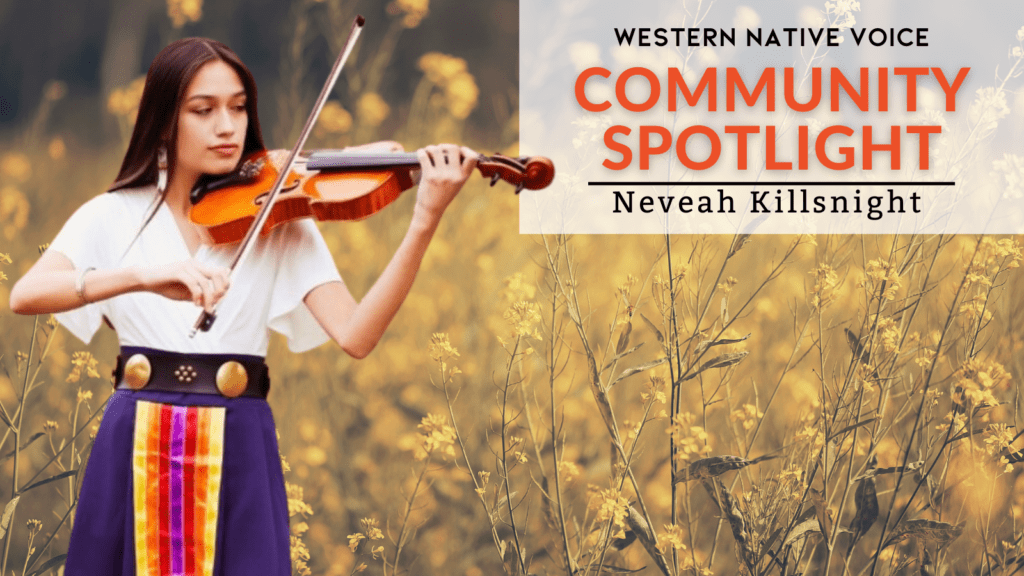
Connecting with community through music and dance.
This month we visited with 18-year-old Neveah Killsnight, an enrolled member of the Northern Cheyenne Tribe. Neveah is heading into her first year of college at the University of Montana, a celebrated violist, and the Summer 2023 Intern at Western Native Voice.
Tell us a little about yourself.
I was born in Bozeman, and my mom was graduating then. She graduated two days before I was born. So I lived in Bozeman for two years, and I don’t remember any of it because I was so young. But then, we moved to Albuquerque, New Mexico, and I lived there until I was ten. Growing up, I loved the food and the culture, but New Mexico was really hot. And then that’s when my mom decided she wanted us to be connected to our culture and know where we come from. That’s when we moved back up to Montana, and we lived in Busby for a little bit with my grandpa for two years. And that’s when I started to jingle dress dance again and learn about my family and everything. I went to St. Labre for two years, and then we moved up to Billings. That was a culture shock because it wasn’t as diverse. I went from being in a classroom of Natives to just me being the only one. That was hard to get used to. Being different isn’t a bad thing.
How was the experience of being the only Native in your class when you moved to Billings? Do you feel like it shaped you in any way?
People didn’t understand why I was quiet or the way my family was or stuff like that. I was different from other people. And because I was in the minority, it felt like nobody really understood me. But as I grew older, I understood that’s just who I am, and I got used to being different.

What made you want to apply as an intern at Western Native Voice?
I wanted to challenge myself and get out of my comfort zone, especially before college. I felt like it would be a good way to prepare. And also, I like the work that Western Native Voice does within the tribal communities.
What’s the most interesting part of being an intern at Western Native Voice?
I’ve learned about many issues in my community that I didn’t know were problems, like the census and voting. I didn’t know about that until now and didn’t realize how huge those were.
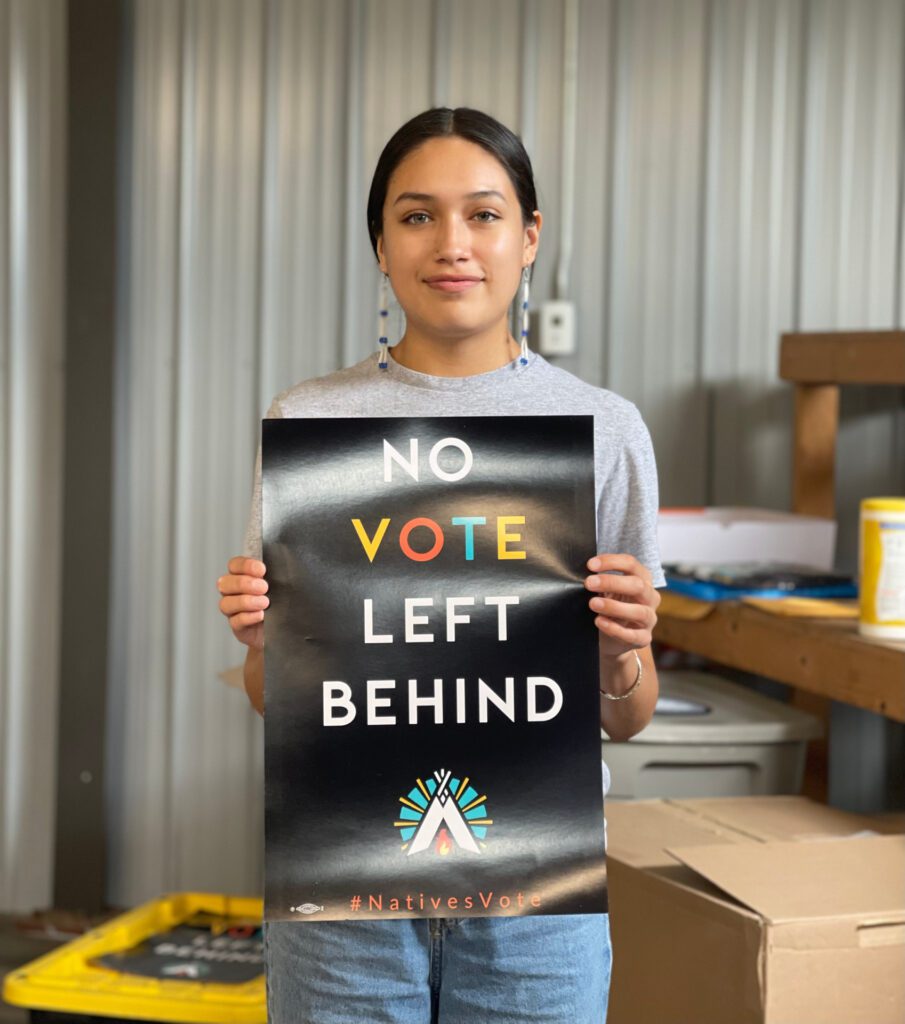
How did your journey into music and playing the viola begin?
I’ve been playing the viola for eight years now. At first, I wanted to quit, but my mom wouldn’t let me. So I didn’t. I’m actually really grateful she said she didn’t let me stop because I’ve traveled a lot because of the viola. I also met a lot of my friends through orchestra, and I love playing music. It’s the main way I make connections with other people. Music can bring people together. When I play music for people in my community, I can bring people together.
How did you come to choose the viola and what did that journey look like for you?
The violin is too high. It hurts my ears, and everyone plays the violin. Nobody knows the viola, so I decided to play it.
I didn’t have lessons when I first learned how to play the viola. For the first three years, I watched YouTube videos and taught myself. I made a lot of progress, which was surprising because it was hard. I also learned how to play the violin and a little bit of the cello. For a lot of families, it’s different. It usually runs in their family if they want to make a career, especially in classical music. Most people start early, when they’re four years old. I got a late start compared to other people trying to make a career out of it. I didn’t get private lessons until eighth grade and made even more progress. But yeah, it all started with YouTube videos.
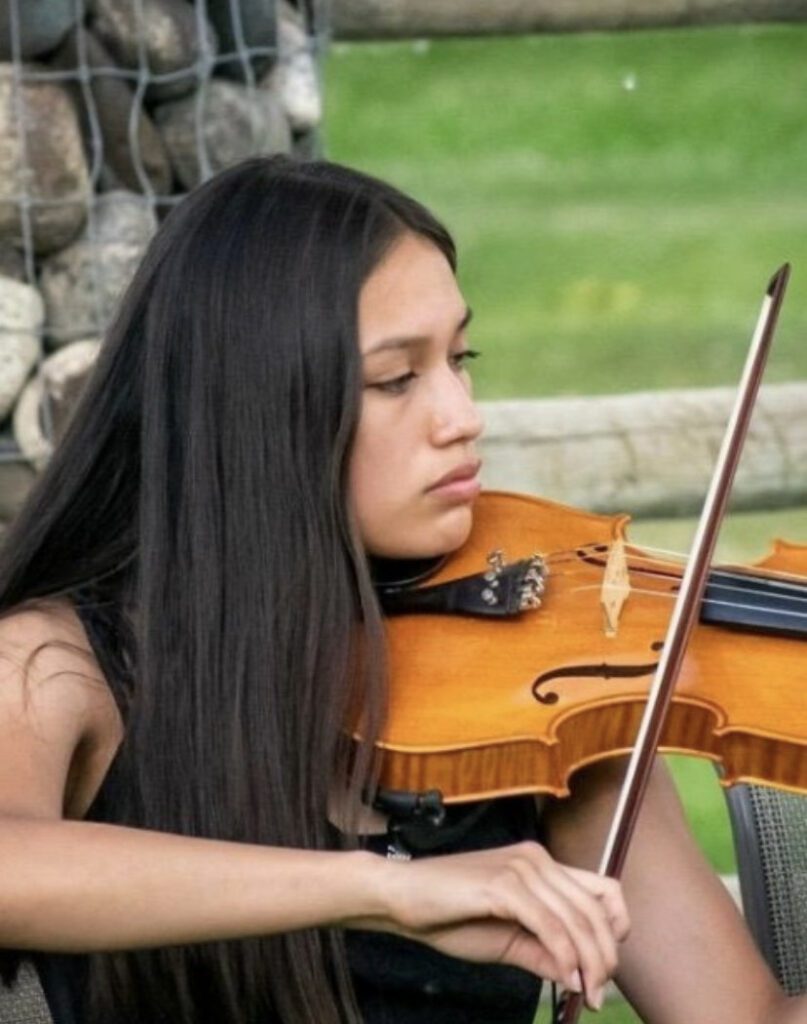
What does the future look like for you and your music?
I’m starting at the University of Montana in Fall 2023 and will study music performance.
I want to play in different symphonies, ensembles, and gigs. And I want to look more into composition because there aren’t many Indigenous composers, artists, or musicians in classical music. I met another Indigenous violist this month, but that was my first time playing with another native in a professional orchestra. When we were talking, she said she only knows of three violists who are native.
How does your culture and community impact the way you play or how you want to play in the future?
My culture and community definitely impact the way that I carry myself.
I represent my whole community while playing in an orchestra, so I have to carry myself well and represent well.
As far as what I play in the future, in classical music, most of the music you learn is 200 years old and written mostly by white men. I know that many new composers are coming out these days from underrepresented communities, and I want to learn and study that kind of music more.
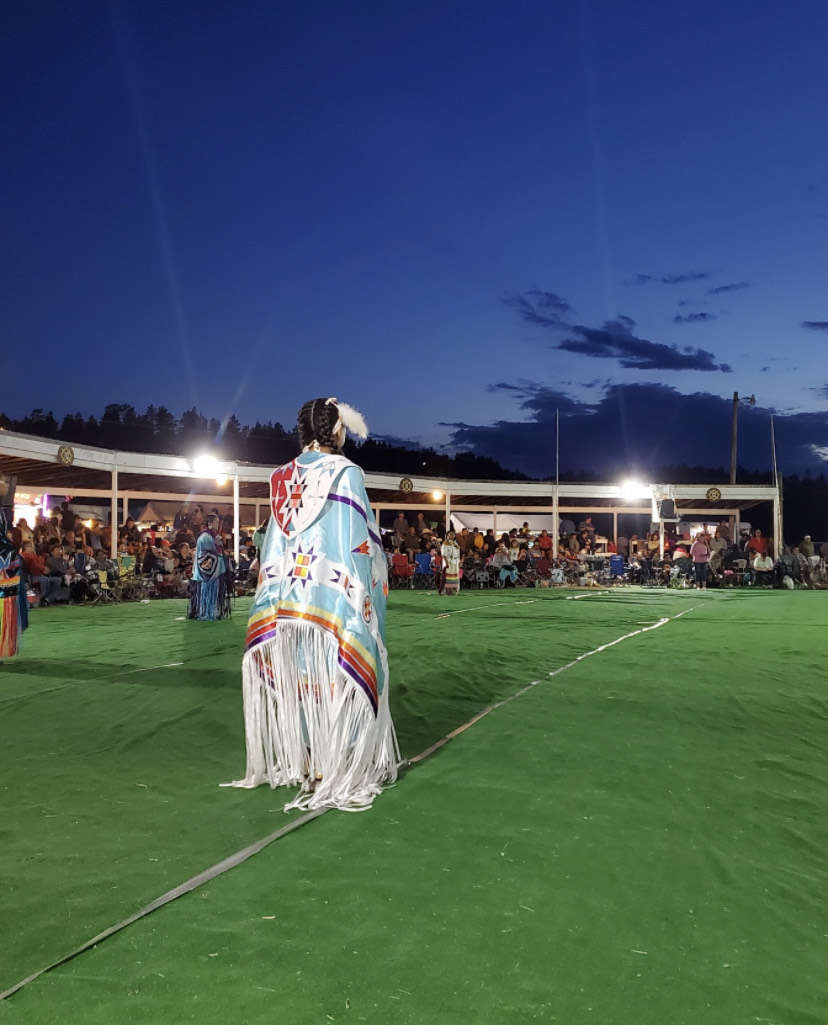
Talk about an experience (good or bad) in your life that was challenging.
I used to dance a lot when I was little and was really into it. But then, when the powwows stopped during Covid, I stopped for a while and got busy with school. I just started dancing again this year, and it’s a lot more challenging than I remember. I used to do Jingle, but now I started doing Fancy, and that’s probably why because Fancy’s like a workout. It’s also hard to put yourself out there when you’re learning and have everyone watch you, but also it’s really fun.
Why do you like to dance?
It’s not just about dancing. It’s also about the powwows. My family is there, and it helps me reconnect. It’s a nice little break from when I’m always in Billings. It’s nice to go back home and see people and dance.
What advice would you give to another Native woman around your age wanting to pursue music, an internship, etc.?
I’m working on getting out of my comfort zone right now. It’s weird but also good for you. Being super uncomfortable can be a good learning opportunity. Don’t be afraid of making mistakes because that’s part of learning. I’m a perfectionist, so I have a hard time making mistakes. It’s okay to make mistakes, and I’m learning that.
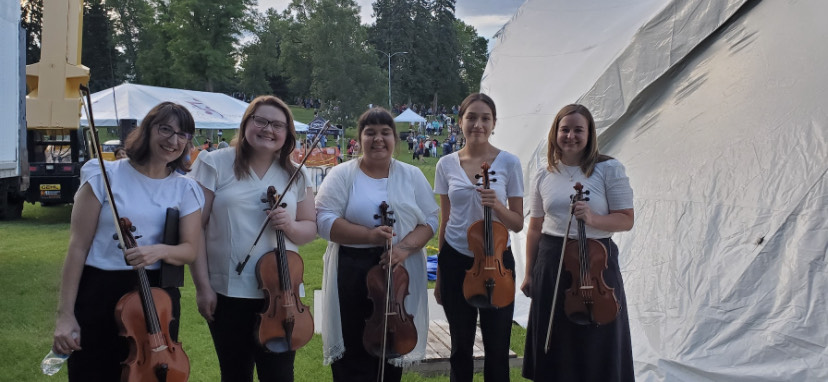

It’s a Deal! The Bumpy Ride to the #1 Radio Station in Montana
Western Native Voice works year-round to inspire Native leadership so our communities flourish. We are excited to share with you Western Native Voice Community Spotlight, designed to highlight grassroots organizing and individuals creating change from across Montana and in Indian Country.
This month, we would like to introduce Jessica Clampitt-Bickham of Billings. She is an enrolled member of the Northern Cheyenne Tribe. Jessica has been a part of the Billings business community for many years and is the owner of radio stations Hot101.9, 105.1 The Bone, 98.5 as well and a host of other ventures.
Here is Jessica’s story in her own words:
Tell me a little about yourself.
My name is Jessica Clampitt-Bickham and I am 37 years old and enrolled member of the Northern Cheyenne Tribe. I am married to Justin Bickham and we have a blended household of five children. I am the owner of radio stations, Hot 101.9, the number one radio station in Montana. I also own 105.1 The Bone, and 98.5 The Wolf. I own Bickham Sealcoating Asphalt repair and maintenance, real estate investing, an event company and I have a food license and liquor license with catering endorsement. I am the prior co-owner at Billings Lifestyle Magazine, co-owner at Billings summer market and co-owner at Amplify studios.
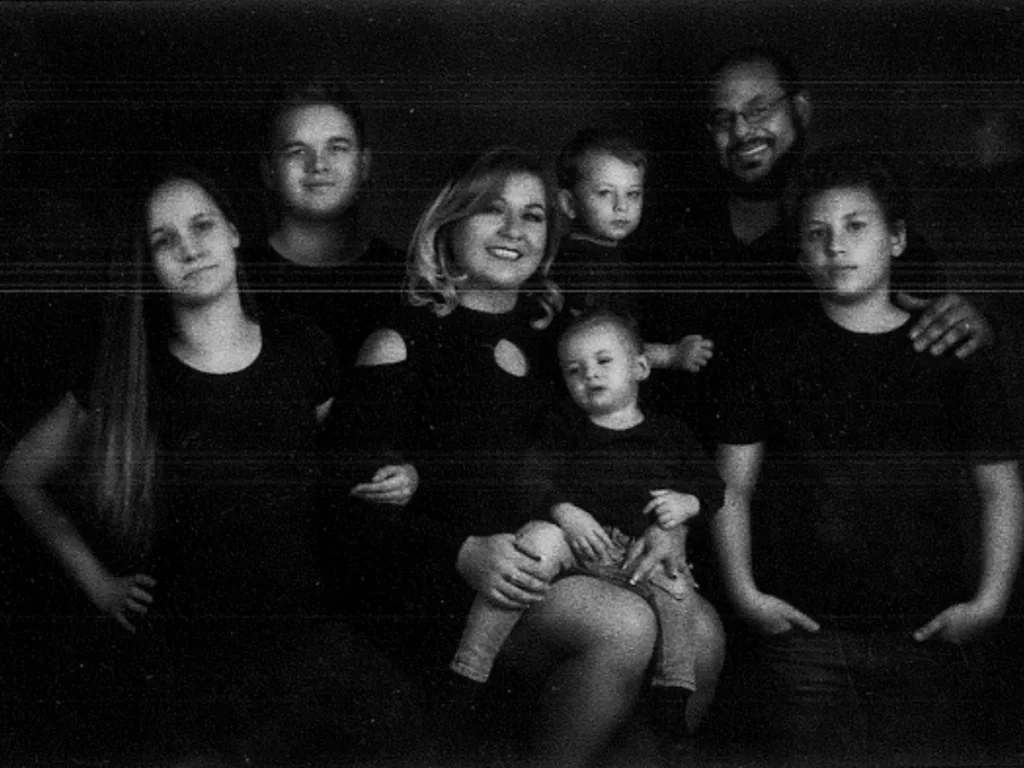
Tell me about growing up.
I grew up on my grandmother’s property on the Northern Cheyenne reservation in a little town called Kirby. My parents were high school sweethearts but divorced when I was about two years old. It led to a very bumpy ride for me when I was growing up. I got out of there as soon as I could when I was 13. At 14, I went to stay with my closest friend in Tongue River. We moved to Arizona with her family but they were having a tough time so I took a greyhound bus back to Colstrip. I was only 14 and going to school and working full time. I looked a lot older for my age, so I started waiting tables. After a while, I eventually rode a bus back to Colstrip to stay with my mom. That is when I met my husband at age 16 and married him at 17. At that point school wasn’t for me and I was ready to take the world on…I had the mindset that I was “old enough”. My husband then became my legal guardian.
We moved to Rapid City, South Dakota after my husband got a small camper. While there I started working for the Spiegel magazine call center and he started with a construction company. It took us about six weeks to get a one bedroom apartment. I was pregnant at that time and my brother also came to live with us. We all lived in one small apartment. Things started looking up, we traded our vehicle in and got two new cars. I then went to work for General electric at age 16…you were supposed to be 18 to work there but I got hired anyway. I became the top sales person in no time.
“I decided to drop out of school…I had the mindset that I was ‘old enough’.”
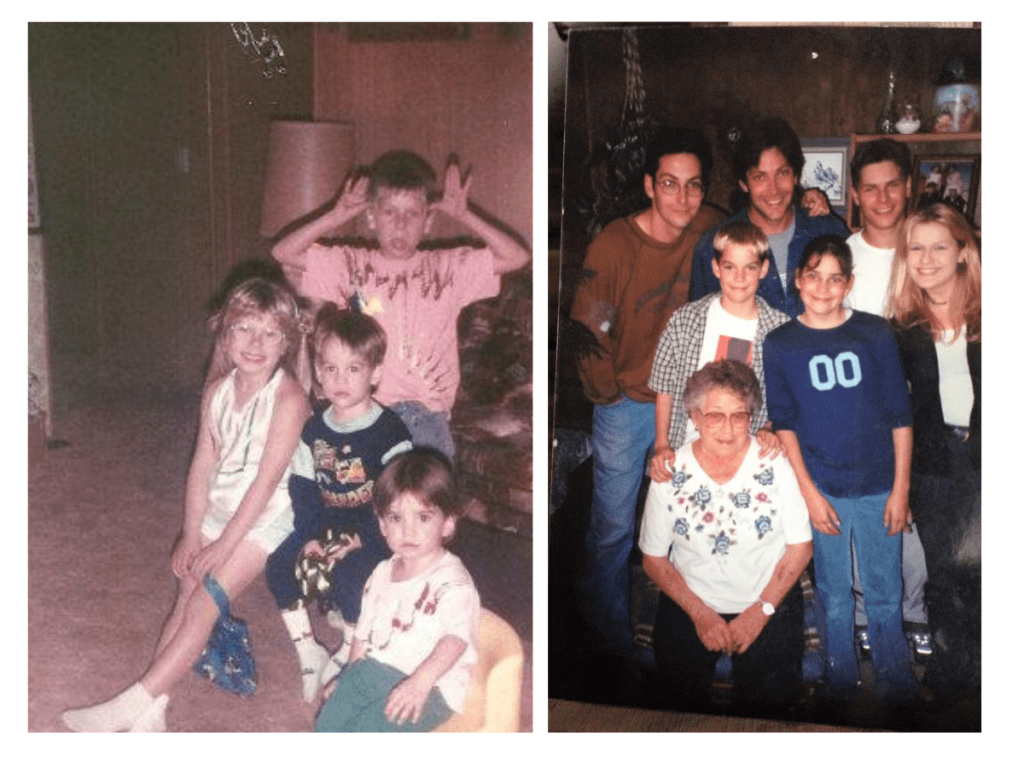
Soon I had my son, Brandon. He was very sick when he was a baby. I, being a brand new mom, kept taking him back to the hospital over and over. Brandon never did crawl and it was late before he even walked. They would check him out and send us home. I was so afraid that he was going to die. Some lady who I didn’t know told me to take him to a nutritionist and as soon as the nurse heard his symptoms, she told me he was allergic to formula. Years later, he was diagnosed with schizophrenia (at age 17). It was activated when he was 17 years old. It was devastating when I got the diagnosis…it was so hard. He is 20 now and it is managed with medication. My son is very appreciative of the quality of life he does have and keeps a positive attitude about it. As a result, I became very educated on mental illness
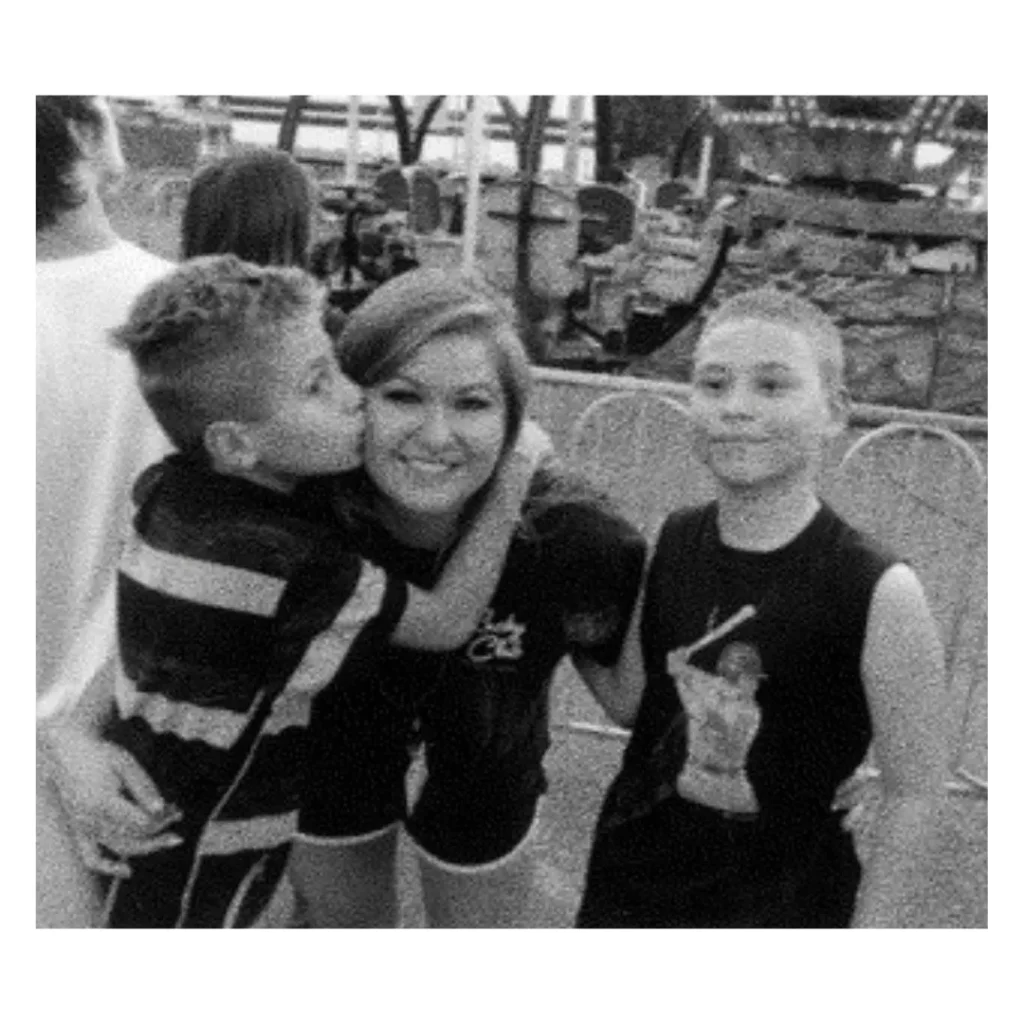
Who were your biggest role models/mentors?
The biggest influence was my mother-in-law, my first husband’s mother. She was the glue that kept the family together and she was my best friend and showed me what family was supposed to be. My father-in-law was a role model to me as well.
Where did you get your work ethic?
My parents were both hard workers and always worked more than one job. I had babysitting jobs when I was 10 and had my own little daycare. I would negotiate with people at 10 years old. My dad said when I was 3 or 4, we went to the store and I bought play money. I went back to the store and tried to buy more play money with my play money…I was already trying to figure it out then.
“I had babysitting jobs when I was ten years old and had my own little daycare.”
Tell me about your education.
School was super easy for me. I am so lucky my whole life, everyone always liked me when I was growing up. I always got special treatment in school. I don’t know what it was. I went to Head Start in Busby with my blonde hair and my rez accent. I didn’t know that I looked different from the other kids there, because I always felt Native. As a child, I got to go to all the sundances and powwows, sweats, etc. The Native American culture has always been a part of my life and I love it.
Did you go to college?
I never went to college but have all my experience. However, I had researched and planned on going to law school. I was always making deals as a child and always dreamed of carrying a briefcase when I got older. My husband says I yell,”It’s a deal” in my sleep when I am dreaming. When I was a little girl I wanted to be a doctor because I didn’t want my grandma to die.
“My husband says I yell ‘It’s a deal’ in my sleep when I am dreaming.”
What hardships or struggles did you have and how did you deal with it?
I struggled a lot with my relationship with my mother, and I had a lot of different childhood and adult traumas. I have the attitude “just keep trucking”. I just had to keep focused on my goals… reaching my goals and pivoting wherever I had to pivot. I utilized counseling to get through some of those traumas, and it helped me. You can take that energy to do positive things. I have had a lot of people open up to me about past childhood traumas. I remind them that it wasn’t their fault and recommend counseling.
I had relationship challenges with my first husband. He and I went back to Wyoming because he was court ordered to go there after getting in trouble with the law. In Wyoming, he ended up going to jail again and we got our vehicles repossessed. I was devastated, it was Christmas Day. I had a vision for my life…I wanted big things for my life. I had my daughter then, and ended up leaving him…he went to prison shortly after.
“I had a vision for my life…I wanted big things for my life.”
That is when I moved to Billings. I started working for KIA and that didn’t work out. I was offered a job as business manager with Connoisseur Media after applying at a job fair. I think they hired me because I had good computer skills and had a good working history. I worked there for seven and half years. We open stations in Rapid City and Bismarck. I worked hard for very little money. Finally I went to ABC/Fox, Charter and those places didn’t work out for me either. I then went to another radio station and became the traffic director. I asked to sell in my free time and within three months I was out billing the highest salesperson. I then opened up my first event center on the side. My employer told me I couldn’t do it while I worked for them. I couldn’t grow the way I wanted to grow, so I decided to go to Arizona. CBS radio offered me a job.
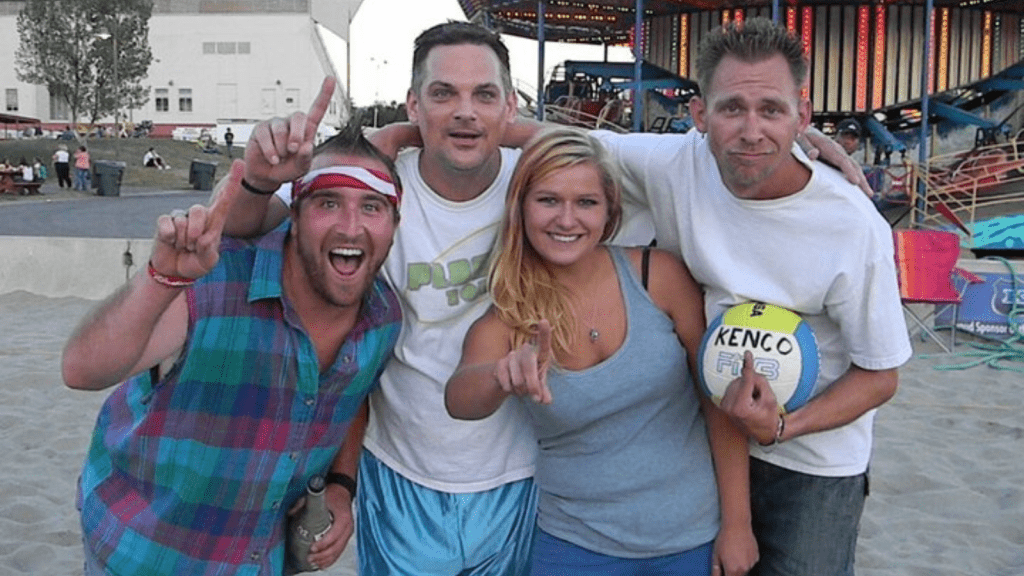
“I asked to sell in my free time and within three months I was out billing the highest salesperson.”
My current employer at the time offered me $15,000 extra for the month to stay on to help transition the new person. I had my going away party and my truck was packed when I found out my boyfriend was cheating on me. He and my kids were already in Phoenix waiting for me to come down, but I called him and told him I was done with the relationship.I had all these huge responsibilities going on in my life. One day, I was sitting crying and my phone beeped, and it was an old boyfriend, Justin, who just decided to reach out to me at the moment. We talked a bit on the phone, and the stars aligned and we both felt a connection. Not long after, Justin and I went down to Phoenix and packed my things and we headed back towards Billings. We stopped in Las Vegas on the way back and got married. I went back to Townsquare to tell them I was back. Not long after, I got in contact with a guy I knew was buying a radio station and I knew he wasn’t experienced. So I started investing. Now he is gone and we own it 100%.
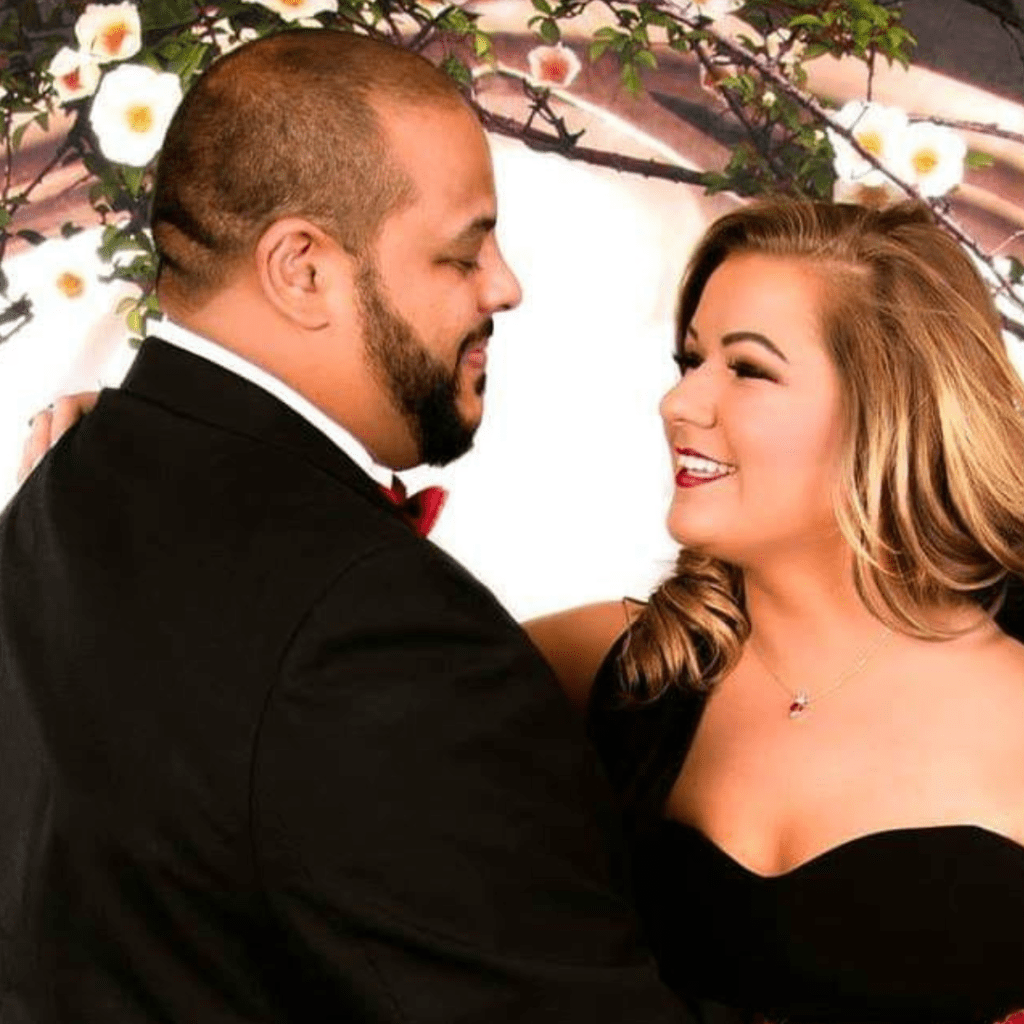
Tell me about your community involvement:
I am the publicist for Yellowstone Tavern Association, I worked with exchange clubs, I have and still sponsor a lot of different community events and organizations like the Babcock Theatre, Native American Development Corporation (NADC), Big Sky Indigifest and other events. I have medical wellness on Wednesdays. I am so busy now, it is so hard to find time to be on boards.
Have you ever run for office?
No. I thought about it. The only reason I haven’t is that when I was 17 years old, I wrote bad checks for food. I got a deferred sentence and paid it back immediately. It still shows on my my record. I realize that wouldn’t make much of a difference now but running for office would take a lot of my time and I don’t have a lot of it right now.
What advice would you give someone about being a business owner?
I would say, don’t put all your eggs in one basket and don’t be afraid to take risks…if you fail once doesn’t mean you will fail again. Just keep trying.
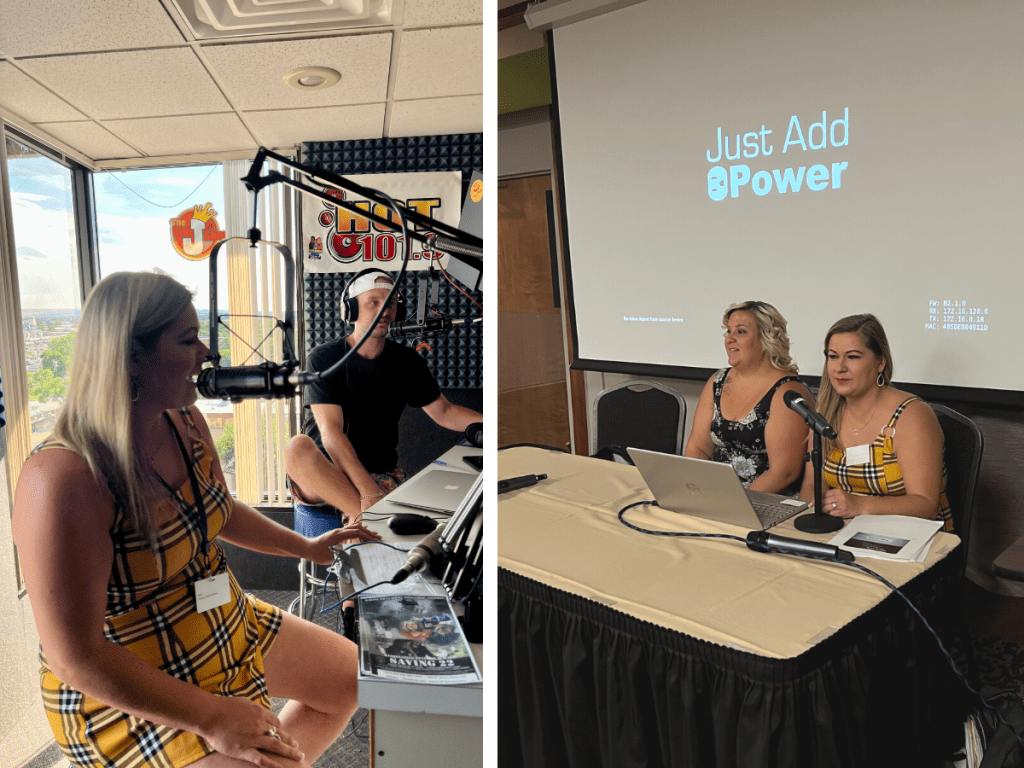
Where do you see yourself doing in the future? What are your dreams for the business?
We are working on Native Section 184 program for housing in Billings. It will be available to all Native Americans and you don’t have to be qualified for special loans. We are currently purchasing property to do that.
My dream is to have a little bit more freedom that I have. I want to take on a partner and have them take over more of the radio station management so I can do more of what I want, and continue to invest in businesses and new ventures.
What would you like to see change in your community?
One thing I would like to see is more Native Americans employed in Billings and more Native American culture here, and I would like to see it continue to grow in our community.
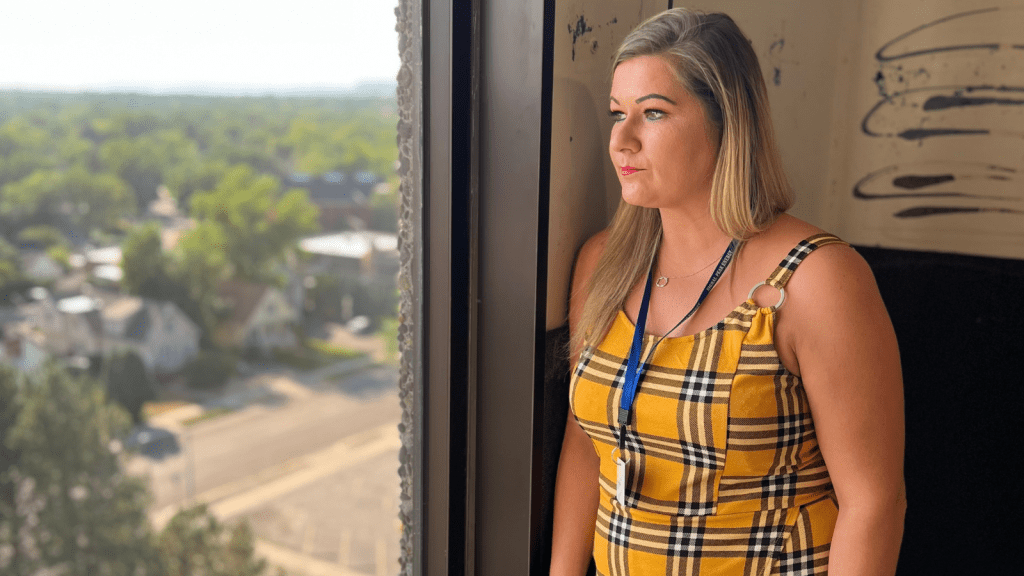
Change Takes Courage. Introducing Northern Cheyenne’s Youngest Council Representative
Western Native Voice works year-round to inspire Native leadership so our communities flourish. We are excited to share with you Western Native Voice’s Community Spotlight, designed to highlight grassroots organizing and individuals creating change from across Montana and in Indian Country.
This month we would like to introduce Silver Little Eagle, 23, Northern Cheyenne’s youngest councilwoman. She is the 7th generation of Little Wolf and Woodenleg and a descendant of Humpback Woman and Little Eagle. Silver was raised by her grandmother, Adeline Fox, who also served on council for 12 years. After graduating from high school, Silver went to Dartmouth College on a Gates scholarship. Here is her story in her own words:
“We are vessels of knowledge, language, resilience, and our ancestors’ blood. I am a 7th generation of Little Wolf and Woodenleg. A descendant of Humpback Woman, Little Eagle, and many strong Cheyenne women. As a 7th generation, it is my duty to carry on our bloodline in a good way and end toxic cycles. This is why I am running for the Lame Deer District Seat. Vote November 3rd, 2020.”
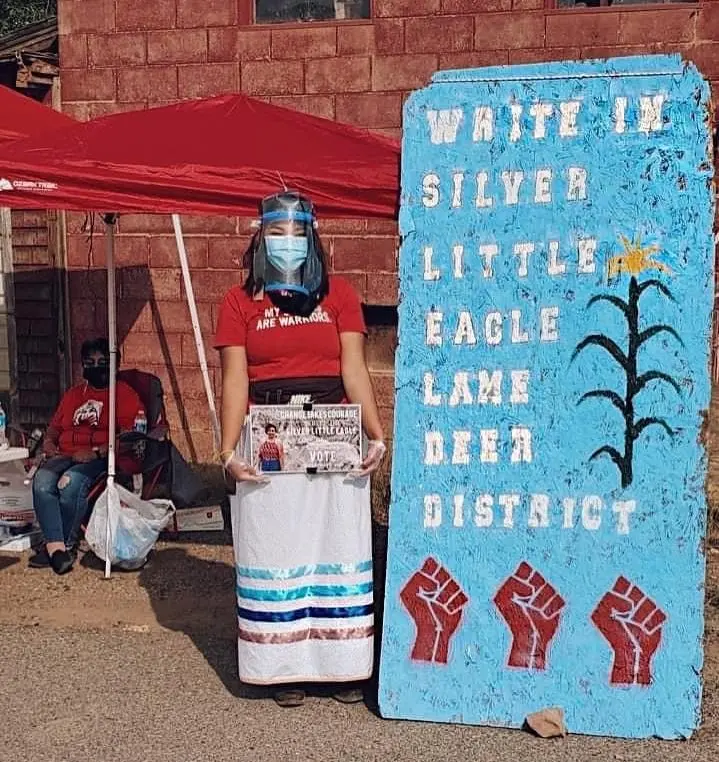
Tell us about your college experience.
I felt that my spirit didn’t want to be there. I felt I wasn’t meant for western education. It took me a long time to accept that. Teachings and classmates….let the bad overpower the good. I felt really poor compared to other Native that were there. There is a class system within the Natives. My family was struggling at home and I had a lot of guilt. I came to believe that ancestral knowledge had more power than institutional knowledge. This belief helped me with my journey.
How did you pick yourself up when you left school?
My family was supportive when I left. I had a friend and boyfriend pass away during that. It was hard to get over my guilt of not going back to school. I went firefighting and it was very healing being on the land.
Would you mind sharing with us what your experience was in running for office?
I was the Activities Coordinator for a year. Spending time with elders all day really helped shape my values and morals. Elders have a medicine that radiates off of them. It affects you. I really support that, and I am a whole new person after hanging out with them. I learned Cheyenne values.
What inspired you to run for office?
All the usual people filed, and the same people were running. I was waiting for somebody to run and trying to encourage them to run. I just went for it as a write-in candidate. I was nervous. I respected the older people that were running and they are all men who we have respect for. I didn’t have a campaign and decided to run a week before. I sent out flyers in the mail locally. On a day of election I had a little drive through. I had the most votes and it was unbelievable. I thought, if I don’t get in at least I tried. 125 people believed in me. My family took me seriously. Grandma helped guide me through the next election. I had to face a lot of comments like she is too young, not experienced. I was told that people are ready for young people and that is why they voted for me.
Why is it important for young people to get involved?
We face different challenges. We have a voice for youth issues. I work with kids such as Boys and Girls Club. I see their challenges. They have suggestions and have solutions that are overseen. With a young person we have different priorities such as having healthy outlets and environmental issues. If I can do it, that shows them they can also run for office.
On average, women are asked at least nine times before they make a solid commitment to running. Why do you think that is?
We are not taken seriously. We change our minds alot. Males were dominant prior to the last election and many were expecting males for these positions. Males are more confident, but now I can feel thoughtfulness and compassion in the meetings. I wonder how different it would be to have even one maie in this chamber. Cheyenne are patriarchal traditionally. True Cheyenne men hold women up high in value and care. We have to be in balance with each other.
Having been through an election, what did you learn?
Providing drive thru meals, social media, mailed flyers really helped with the election. We reached out to elders and younger people. It was pretty cool to see my name on other people’s social media. It felt good to have an elder come up to me and say, “Hey, I am going to vote for you”.
“I am asking you, the people to believe in me. We – the youth, the elders, the people have been burned and discarded by so many generations of councils. Campaigns of broken promises and excuses. If you do not believe in me, it’s fine. Because how can you win over someone’s trust after trust has been violated by cycles and cycles of toxic masculinity and tribal government excuses?
“If you choose to believe in my leadership, I will show up. I am showing up and will continue to show up for the community elected or not. Those who know me – know me to be an underground worker. Somebody who shows up not for the clout, not for the cameras – but for the well-being of others. I show up because I love our community. I love our language. I love our stories. I love our legacy.”
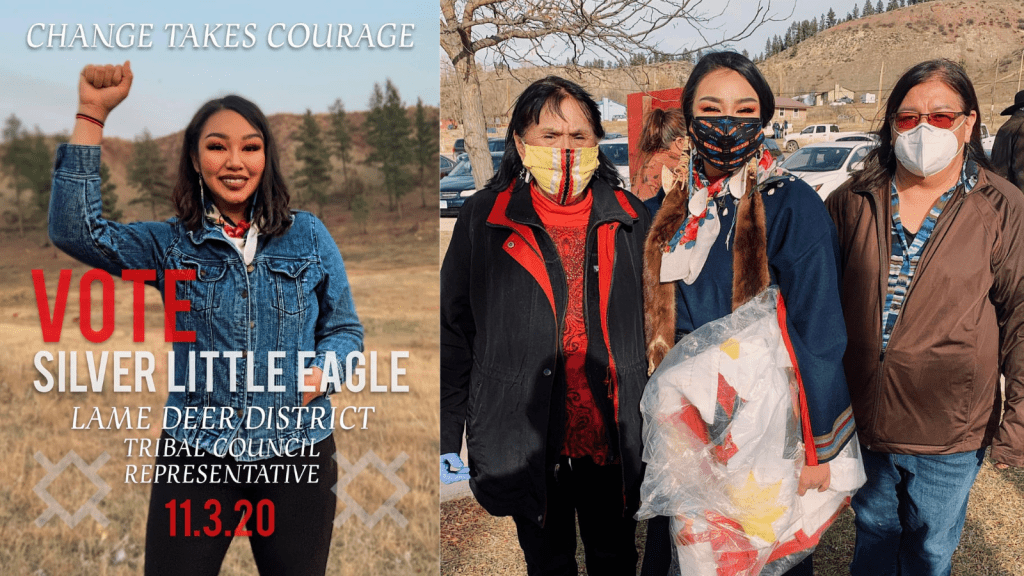
Who was your inspiration growing up and/or role model?
My grandma, Adaline Fox. She raised my brother and me. She is assertive and stern. She is someone I want to be. Right now I am soft spoken. Dezi Rodriguez who is a Cheyenne who went to LaBrea and who graduated at Stanford. She is active in Data Collection. Merca Spang who as a little girl, I saw pictures of her at my school. She went to Dartmouth.
What would you tell others who want to run for office?
Just do it. My Auntie told me the story of Buffalo Calf Robe Woman. Do you think she waited too long to save her brother? She just did it. That is what really calmed me down when I was running for office. My journey is exactly where I am meant to be.
What would you want the outside world to know about the communities that you consider home?
In Lame Deer, we are close knit and we know each other. Our lives are valuable. We are passionate and we are trying to be leaders that care as a collective, that care for everyone not just certain ones. Even the people that walk around all day have values and dreams that matter. My goal is to help them remember who they are…Cheyenne. We have our own spirit and values. That’s who makes us who we are by going back to those values. This current leadership will help us with these goals.
Do you see yourself running for higher offices in the future?
I want to focus more on ground movements that shake the earth. Oak Flat, Standing Rock, all these movements were started from grounds work people.
What is one change you would want to see in your community within the next five years?
I would like to see more community connections such as gardens, community halls, helping each other out. More renewable energy as we are facing challenges with electric companies. I have a vision of solar panels going up in my lifetime.
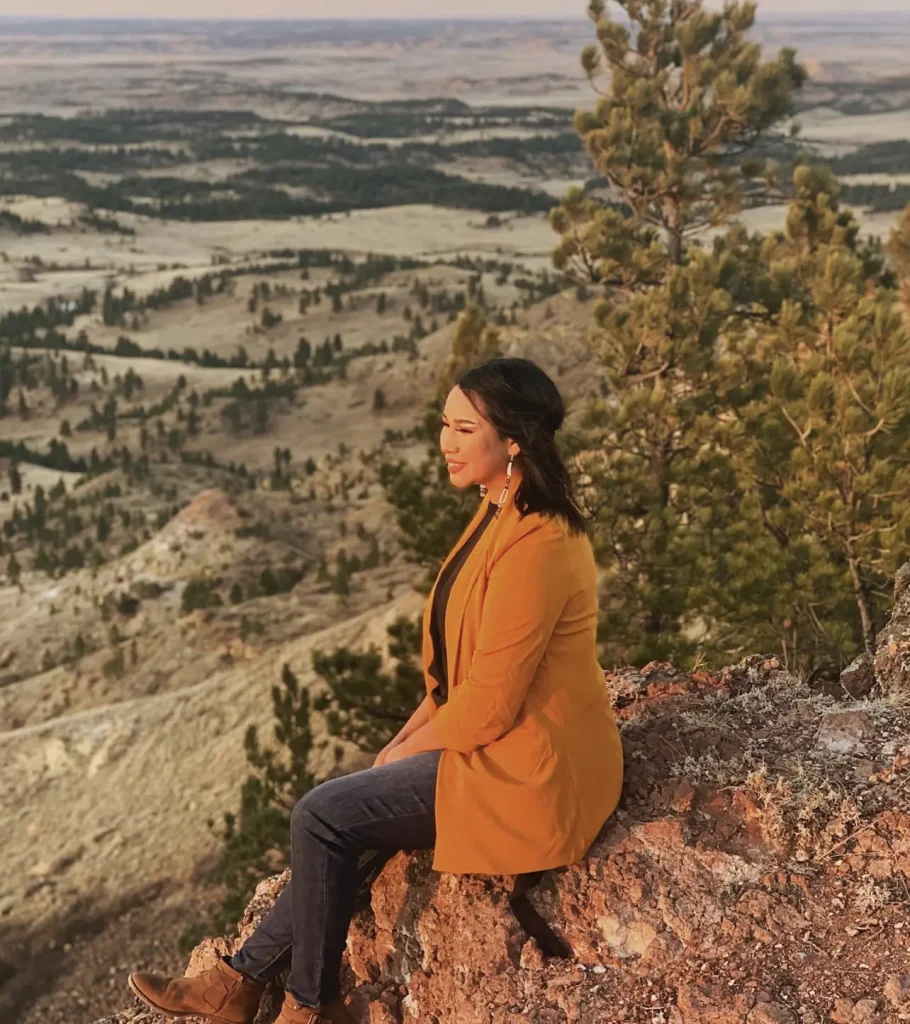
Father/Child Highlight MMIWG & MMIP Movements with Art Project
Western Native Voice works year-round to inspire Native leadership so our communities flourish. We are excited to share with you Western Native Voice’s Community Spotlight, designed to highlight grassroots organizing and individuals creating change from across Montana and in Indian Country.
This month we would like to introduce artists Major Robinson and his 17-year-old child, Kyra Robinson, both enrolled members of the Northern Cheyenne Nation. Kyra will be a senior in high school and is a part of the LGBTQ+ community. Kyra’s pronouns are they/them. Major and his wife Michelle own Sage & Oats Trading Post in Helena Montana.
Tell us about your project.
Kyra and I worked on a special father/child sticker art project highlighting the MMIWG (Missing & Murdered Indigenous Woman & Girls) and MMIP (Two-Spirit) movements.
Sage & Oats Trading Post offers American Indian and Montana immigrant artisan products and gifts. Kyra and I worked on a special father/child sticker art project highlighting the MMIWG (Missing & Murdered Indigenous Woman & Girls) and MMIP (Two-Spirit) movements. We are selling the stickers and candles at Sage & Oats to raise awareness for the MMIWG and MMIP movements. A portion of the profits of each candle sold will go towards the work Western Native Voice is doing to illuminate the importance of these Indigenous issues in Indian Country.
How did you get started with your career, and was there a specific event that prompted you to take action?
Growing up on my reservation in Montana, I used art to express my feelings. Now I get to make a living through creating art. I worked for many years designing theme park sets and rides for companies like Disneyland and Universal Studios. My wife and I wanted to promote careers in the arts, and so we opened Sage & Oats. After creating our shop, Kyra became active in creating art and displays for the business. It has helped them to learn what it is like to have a job where they can use their artistic skills.
What opportunities do you have for youth who want to get started in the business?
In the past, we have hired young staff members to help with the store and encouraged them to create their art to sell. We are not hiring right now, but we continue to encourage artists of all ages to discover what they enjoy creating. We speak to them about ways to get their art produced for the public to see, appreciate, and purchase. At Sage & Oats, we also use our designs to produce stickers, t-shirts, and other products.
In what ways are you involved or give back to your community?
One way we give back to our community is by featuring the art of Native artists from the reservations in Montana in our store and website at www.sageandoats.com. This allows them to get their art to a larger market while being able to stay with and provide for their families on the reservation. We also have special products we sell and give a portion of those profits to various community organizations. We also have made direct donations to organizations such as the Last Chance Pow-Wow committee and various non-profit organizations.
In addition, Kyra uses art to raise awareness about issues in their communities that aren’t typically discussed (both Native communities and the LGBTQ+ community), while also showing the world there are things to celebrate in each community. Sometimes people outside of these communities focus so much on the negative, and we want to show them we are more than the challenges we face.
How did you handle any adversity or doubt?
There are a few lessons we have learned to help us deal with adversity or doubt. Always look at challenges as opportunities to try something new. If it didn’t work, one way doesn’t mean it won’t work another way. Don’t be too proud to ask for help. Any successful person had a bunch of people that helped them get where they are. Ask for help when you need it. We have so many family members and friends who have helped us get where we are today.
Kyra experienced adversity because of the color of their skin. Ironically, as a light-skinned Indigenous person, they were told they don’t “look Native.” Kyra realized there isn’t one way to “look Native,” and regardless of appearance, they know who they are and where they come from. At a young age, Kyra had doubts about their artistic abilities. In fifth grade, Kyra compared themself to a friend who was amazing at art and felt like their art was not good enough. When Kyra told their mom, she said Kyra should not compare their art to their friend’s work. That moment helped Kyra to realize they could both be artists, and if Kyra wanted to improve their work, they had to keep creating art.
What support systems did you have to help you get started?
Kyra and I both believe our main support system is our family. This includes our biological family as well as our chosen family, such as our Cheyenne adopted family members (like Grandpa Richard Tallbull). Kyra was always encouraged to pursue art, even as a potential career. We also have very close friends who we have shared our personal goals and dreams with. They continue to encourage us to keep going when it gets difficult.




